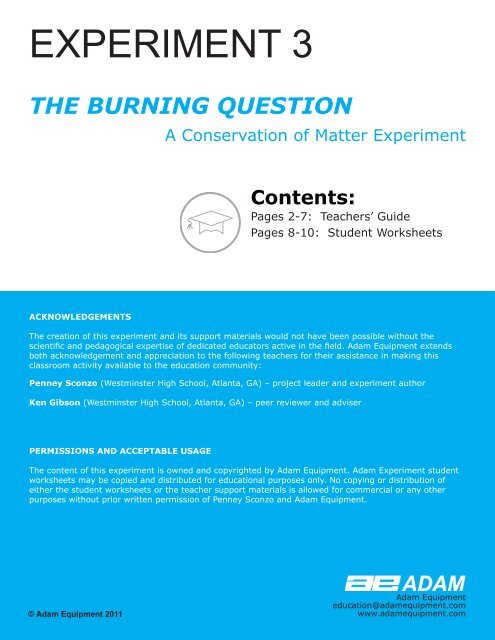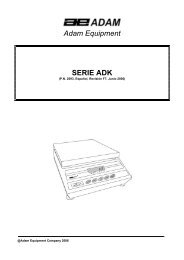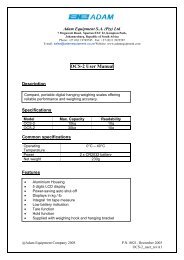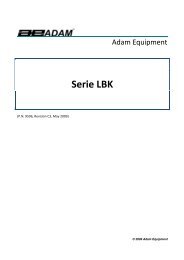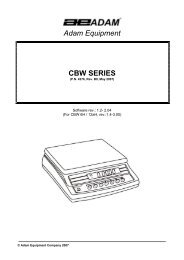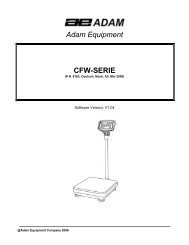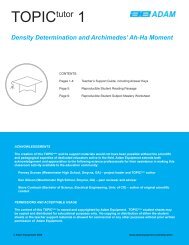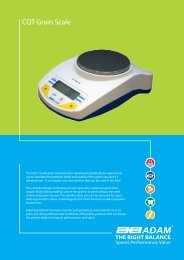Experiment 3 THE BURNING QUESTION - Adam Equipment
Experiment 3 THE BURNING QUESTION - Adam Equipment
Experiment 3 THE BURNING QUESTION - Adam Equipment
You also want an ePaper? Increase the reach of your titles
YUMPU automatically turns print PDFs into web optimized ePapers that Google loves.
EXPERIMENT 3<strong>THE</strong> <strong>BURNING</strong> <strong>QUESTION</strong>A Conservation of Matter <strong>Experiment</strong>Contents:Pages 2-7: Teachers’ GuidePages 8-10: Student WorksheetsACKNOWLEDGEMENTSThe creation of this experiment and its support materials would not have been possible without thescientific and pedagogical expertise of dedicated educators active in the field. <strong>Adam</strong> <strong>Equipment</strong> extendsboth acknowledgement and appreciation to the following teachers for their assistance in making thisclassroom activity available to the education community:Penney Sconzo (Westminster High School, Atlanta, GA) – project leader and experiment authorKen Gibson (Westminster High School, Atlanta, GA) – peer reviewer and adviserPERMISSIONS AND ACCEPTABLE USAGEThe content of this experiment is owned and copyrighted by <strong>Adam</strong> <strong>Equipment</strong>. <strong>Adam</strong> <strong>Experiment</strong> studentworksheets may be copied and distributed for educational purposes only. No copying or distribution ofeither the student worksheets or the teacher support materials is allowed for commercial or any otherpurposes without prior written permission of Penney Sconzo and <strong>Adam</strong> <strong>Equipment</strong>.© <strong>Adam</strong> <strong>Equipment</strong> 2011<strong>Adam</strong> <strong>Equipment</strong>education@adamequipment.comwww.adamequipment.com
<strong>THE</strong> <strong>BURNING</strong> <strong>QUESTION</strong>A Conservation of Matter <strong>Experiment</strong>GRADE LEVELThis experiment is designed for grades 9-12. It can be adapted for grades 6-8.1TeacherGuidePURPOSES• To demonstrate the Law of Conservation of Matter.• To dispel common misconceptions about combustion reactions.• To have students analyze data that has been collected using laboratory equipment(balances).SUBJECTSChemical reactions, chemistry, science as inquiry and data analysis.TIME NEEDEDOne laboratory period. Additional time may be required for analysis of data and additional discussions.ACTIVITY OVERVIEWStudents burn steel wool in both an open and closed environment to understand what happens to matter during achemical reaction.This lesson is designed to easily and quickly integrate into existing curriculum. It comes complete with a three-pagestudent handout, standards correlations, vocabulary lists, plus extensions and assessment tools with answer keys.This <strong>Adam</strong> experiment is appropriate for remedial, review, reinforcement, or extension purposes.HELPFUL ADVICE TO MAXIMIZE SAFETY AND STUDENT SUCCESS1. It is best to use medium-coarse steel wool. Fine steel wool might contribute to popping out of the evaporating dishand onto the counter. Do not use steel wool with soap added, such as Brillo pads.2. For safety purposes, wear safety goggles during this experiment and also remove paper from the area where thesteel wool is being heated.3. Burn steel wool samples in a pre-massed evaporating dish so any pieces of steel wool that break off can still beincluded in the total mass. Otherwise, student measurements might support the idea that mass decreases in acombustion reaction.4. Exercise care when heating steel wool. Do not hold the sample piece directly in a Bunsen burner flame. If aburning splint is used to start the burning, quickly remove the splint after igniting the sample. Vigorous heatingcould produce popping which will reduce the gain in mass to be measured.5. The difference in mass for this small sample of steel wool will be very small. Every bit counts so using theevaporating dish and taking steps to prevent popping will eliminate some error.6. To prevent burns, remember to cool the test tubes and the evaporating dish before handling or weighing.7. Discuss the accuracy of centigram balances. A very slight difference in mass in part two of this experiment mightnot represent a real change because of the machine’s repeatability within ±0.01g.Page 2© <strong>Adam</strong> <strong>Equipment</strong> 2011
CONNECTIONS TO NATIONAL SCIENCE AND MATH EDUCATION STANDARDSSCIENCE CONTENT STANDARD A - SCIENCE AS INQUIRYConcept 1 - Abilities necessary to do scientific inquiry:1. Develop descriptions, explanations, predictions, and models using evidence and explanations (grades 5-8).2. Formulate scientific explanations and models using logic and evidence (grades 9-12).3. Using mathematics in scientific inquiry (grades 5-12).SCIENCE CONTENT STANDARD B - PHYSICAL SCIENCEConcept 3 - Understanding chemical reactions (grades 9-12).MATH CONTENT STRAND 2 - DATA ANALYSIS, PROBABILITY AND DISCRETEMA<strong>THE</strong>MATICSConcept 1 - Understand and apply data collection, organization and representation to analyze and sort data (grades5-12).MATH CONTENT STRAND 4 - GEOMETRY AND MEASUREMENTConcept 4 - Understand and apply appropriate units of measure, measurement techniques, and formulas to determinemeasurements (grades 5-12).KEY VOCABULARYANTOINE LAVOISIER: A French pioneer in modern chemistry who, during the 1770’s, was one of the first scientiststo understand the importance of measurements. Considered by many to be the Father of Modern Chemistry, he is alsonoted for his discovery of the role that oxygen plays in combustion.ATOM: The building block of all matter; the smallest particle of an element that has the chemical properties of theelement.BATTERY TERMINAL: The connection point for electrical current on a battery/conductor.CHEMICAL REACTION: The process in which substances undergo chemical changes, forming new substances withdifferent properties.CENTIGRAM: A fundamental unit of mass used in the metric system (equal to one hundredth of a gram).COMBUSTION: A reaction where a substance chemically combines with oxygen while being burned.CORROSION: The process where metals wear away gradually. The most common form of corrosion is rusting whichoccurs when iron combines with oxygen and water.FLAMMABLE: Easily ignited and capable of burning rapidly.GRAM A fundamental unit of mass used in the metric system (equal to the weight of one cubic centimeter of distilledwater at 4°C).LAW OF CONSERVATION OF MATTER: Matter cannot be created or destroyed. Matter is simply rearranged in achemical reaction.MASS: A measurement that reflects the amount of matter (more precisely, the sample’s weight divided byacceleration due to gravity).OXIDIZE: To combine with oxygen in a chemical reaction, as in burning or rusting.PHLOGISTON <strong>THE</strong>ORY: A former theory of combustion in which all flammable objects contained a substance calledphlogiston.QUANTITATIVE ANALYSIS: A type of chemistry dealing with accurate measurements of the amounts or proportionsof the various elements in a substance.REACTANT: A substance that is part of a chemical reaction, and is present at the start of the reaction.VAPORIZATION: The conversion of a solid or a liquid into a gas.VOLATILE: Evaporating or vaporizing very quickly at normal temperatures and pressures.© <strong>Adam</strong> <strong>Equipment</strong> 2011 Page 3
SAMPLE DATAEXPERIMENT 1: Open SystemMass of steel wool 1.13gMass of evaporating dish 50.75gMass of steel wool and dish 51.88gMass of burned steel wool and dish 51.99gMass of burned steel wool 1.24gEXPERIMENT 2: Closed SystemMass of test tube 42.78gMass of steel wool 0.70gOriginal Mass of steel wool and test tube 43.48gMass of steel wool and test tube after burning 43.49gMass of burned steel wool 0.71gEXTENSION: Closed System With Increased Oxygen EnvironmentTest tube 42.77gSteel wool 0.69gTest tube + steel wool 43.46gTest tube + steel wool after burning 43.47gSteel wool after burning 0.70gCONTROL TEST: Closed System With Nitrogen EnvironmentNOTE: This control was teacher-tested to support the experimental datacollected. This experiment does not have to be repeated but data is shownfor the teacher’s benefit.Test tube 42.13gSteel wool 0.68gTest tube + steel wool 42.81gTest tube + steel wool after burning 42.81gSteel wool after burning .67gPage 4© <strong>Adam</strong> <strong>Equipment</strong> 2011
ANSWER KEY FOR STUDENT ASSESSMENT SHEET1. Initially, steel wool is a silver gray color with a little shine to it. After the combustion reaction, the steel woolappears a darker bluish-gray in color and there is less shine. The mass of the steel wool has increased.2. a. There was a yellow-orange light or glow.b. There was a color change. (Note: The increase in mass is calculated from a measurement, and should notbe included as an observation.)3. If the steel wool gets heavier without adding anything that is visible to it, your little brother might think some newmatter was created.4. The mass of the steel wool sample increased when the iron (Fe) combined with oxygen (O 2) in the air.4Fe (s)+ 3O 2 (g)à 2Fe 2O 3 (s)5. The steel wool is heated differently. In the first experiment the heat from the glowing surface, the steel wooland the air are all in direct contact. The steel wool is heated as it burns and it is in direct contact with the air. Inthe second experiment, the test tube, the air, and the steel wool are being heated, but the heat is not in directcontact with the steel wool. Attaching the balloon prevents air from moving freely in and out of the balloon.6. Only a color change indicates a chemical reaction might have occurred.7. There is no light or glow observed. The reaction might be incomplete which would explain less of an increase inmass.8. An increase in the mass of the steel wool must be balanced by a decrease in the mass of free oxygen moleculesin the air. In the first experiment, the increased mass of the steel wool is measured and recorded. No attemptis made to determine if any oxygen is removed from the air. In the second experiment where there is a closedsystem, the color of the steel wool indicates formation of a new product. Oxygen is removed from the air as itchemically combines with the iron of the steel wool. As the mass of the steel wool increases, the mass of the air inthe tube must decrease. In a closed system, the total mass will remain constant as the oxygen simply moves fromthe air to the steel wool where a new substance forms. The total mass of the closed system remains constant. Paycareful attention to the balloon!9. When rusting occurs the properties of the metal changes. Corrosion weakens the iron because the iron oxide(rust) flakes off, and the amount of steel wool is reduced.10. The corrosion of iron can be slowed down or prevented by not permitting the metal to come in contact withoxygen. This can be done by painting, coating with oil, or galvanizing (coating with zinc) the sample of iron.POSSIBLE EXTENSIONSBurning steel wool in a closed system filled with extra oxygen.1. This part is conducted by the teacher but students are to record data during the procedure.2. TEACHER: Repeat all steps to of <strong>Experiment</strong> 2 with this modification to Step 4: Flush the test tube with oxygenand slightly inflate the balloon with oxygen to a diameter of approximately 10cm.3. STUDENTS: Record mass of test tube, steel wool and steel wool with test tube. Make observations after heatingand also once test tube has cooled completely. Mass the test tube with the steel wool inside.4. Compare and contrast the results from the closed system where a sample of steel wool was burned in air(experiment 2) versus the results from this extension where the sample is burned in a closed system with anenriched oxygen environment.© <strong>Adam</strong> <strong>Equipment</strong> 2011 Page 5
ADDITIONAL RESOURCESVisit www.adamequipment.com/education regularly for new classroom resources.ABOUT ADAM EQUIPMENT<strong>Adam</strong> <strong>Equipment</strong>’s world headquarters is located in Milton Keynes, United Kingdom, with facilities in the United States,Australia, South Africa and China. The company’s balances have been trusted by professionals worldwide for 40 years.Contact <strong>Adam</strong> <strong>Equipment</strong> at education@adamequipment.com or online at www.adamequipment.com/education.ADAM EQUIPMENT BALANCES RECOMMENDED FOR THIS EXPERIMENTHighland Portable Precision BalanceModels recommended for this experiment:HCB 302 Portable Balance (300g capacity x 0.01g readability)Complete with more features and accessories than any other in its class, <strong>Adam</strong><strong>Equipment</strong>’s Highland Portable Precision Balances have what it takes for school andcollege applications. The reliable Highland provides the latest in weighing technology,15 weighing units with four weighing modes and it is easy enough for novice students.It features <strong>Adam</strong>’s unique patented ShockProtect overload protection to withstandup to 200kg, and HandiCal internal calibration with built-in mass. Calibrate wheneveryou want without external masses or use your own masses. USB and RS-232 interfacesare both included with cables. The rechargeable battery (adapter/charger included),removable draft shield and brilliant backlit display with capacity tracking makeHighland the most complete portable precision balance available. Available in sevenmodels from 150g x 0.001g to 3000g x 0.1g. For complete product details, visit www.adamequipment.com/education.Core Portable Compact BalanceModel recommended for this experiment:CQT 202 (200g capacity x 0.01g readability)Compact and durable, no other balance can beat the Core for basic weighing value. Thetough, durable ABS housing is designed to withstand classroom environments, whilebeing easy to clean and protected from accidental spills. With built-in ShockProtectoverload protection, Core balances can handle excessive overloads without a problem.The simple keypad with dual tare keys and a brilliant backlit display make Core balanceseasy to use. Complete with a removable draft shield, AC adapter, and integral securityslot, Core balances are ready to work right out of the box.GETTING INVOLVED IN ADAM EQUIPMENT’S EXPERIMENTSFeedback On This <strong>Adam</strong> <strong>Experiment</strong>If you have feedback on this <strong>Adam</strong> <strong>Experiment</strong> that would be valuable to other teachers, we encourage you to shareyour thoughts. Please email your comments to <strong>Adam</strong>’s education division at education@adamequipment.com.Submitting Your Own <strong>Experiment</strong>If you have an idea for a useful educational resource that you would like to share with other teachers, <strong>Adam</strong><strong>Equipment</strong> is interested in hearing from you. Initial submissions need to include only a simple description of theactivity with the activity’s purpose, subject, and grade level. Please contact <strong>Adam</strong>’s education division by e-mail ateducation@adamequipment.com to determine if your particular activity will fit into our experiment library. <strong>Adam</strong><strong>Equipment</strong> will respond promptly to all inquiries.Page 6© <strong>Adam</strong> <strong>Equipment</strong> 2011
<strong>THE</strong> <strong>BURNING</strong> <strong>QUESTION</strong>A Conservation of Matter <strong>Experiment</strong>2StudentSectionINTRODUCTIONOne of the properties of matter is its ability to burn or to support combustion. Inthe 18th century, the French chemist Antoine Lavoisier determined that whenmatter burns, the oxygen in the air combines with the matter. Lavoisier conductedexperiments so that none of the productsof burning could be lost. He carefullymeasured the mass of all the reactants atthe beginning of the experiment then hemeasured the mass of all the products atthe end of the reaction. Lavoisier had thebest laboratory money could buy and he wasmeticulous in taking those measurements.From his work, Lavoisier came up with atheory about combustion that was far betterthan the popular Phlogiston Theory.The Law of Conservation of Mass states that the total mass of all the reactantsbefore a chemical reaction must be the same as the total mass of all theproducts after the chemical reaction has finished. For this to be true, the totalnumber of atoms involved in the reaction must be constant. The total massdoes not change because the total number of atoms does not change. Atomsare conserved in a chemical reaction.Consider the starting mass and the final mass in common chemical reactionssuch as Alka-Seltzer ® dissolving in water, a candle burning, or iron rusting.Observe a piece of wood before and after it has been burned. What productsare formed? What similarities and what differences are there between thereactants and the products in this reaction? How does the final mass of theproducts compare to the starting mass of the reactants?ANTOINE LAVOISIERThe Father of Modern ChemistryA French pioneer in modern chemistrywho, during the 1770s, was one ofthe first scientists to understand theimportance of measurements. Hechanged chemistry from a qualitativeto a quantitative science.PURPOSEWhat changes are anticipated when a piece of steel wool burns? Would burning a sample of steel wool in an openair environment have a different outcome from burning the sample in a closed container? By conducting theseexperiments, you’ll be able to answer these burning questions and you will come to a better understanding of the Lawof Conservation of Matter.WHAT YOU NEED• Steel wool pads, #0 grade• Wooden splint• Acetone• Rubber balloon, helium quality• Aluminum foil• Glass rod• Large, rimmed test tube (2.5cm x 19.5cm)• 250 mL beaker• Bunsen burner• New nine-volt battery• Safety goggles• Large evaporating dish (metal, porcelain or glass)• CQT 202 or HCB 302 balanceMAKE A HYPO<strong>THE</strong>SISPredict any changes to the mass of a piece of steel wool when it is burned. Will burning the steel wool in a closedcontainer change your prediction? Write two separate hypotheses for any changes you predict, one hypothesis forburning the steel wool in open air and another hypothesis for burning steel wool in a closed container.© <strong>Adam</strong> <strong>Equipment</strong> 2011 Page 7
STUDENT PROCEDURESTeacher preparation of steel wool1. Remove a small section of a steel wool pad and open the weave to increase the surface area. A 10g to 15g pieceshould be enough for a class of 20 students, working in pairs.2. Place the piece of steel wool into a 250mL beaker and add enough acetone to cover the strands of the pad. Coverthe beaker with foil to reduce vaporization. Swirl to keep the acetone moving over the strands of steel wool anduse a glass stirring rod to make sure all the strands have good contact with the acetone. Soak for five minutesto remove the protective coating on the strands. Caution: Acetone is volatile and extremely flammable.Handle with care and keep away from heat sources.3. Use the glass rod to remove the pad from the acetone and carefully shake any excess acetone into a sink.Immediately flush the sink with water. Place the steel wool on a paper towel and allow it to air-dry. Acetoneevaporates quickly, so this should only take a couple of minutes.<strong>Experiment</strong> 1: Burning of steel wool in an open system(Make sure to wear safety goggles during the burning procedure)1. Remove a small section of steel wool (approximately 1.0 grams) that has been cleaned with acetone. Place thesample on a centigram balance and record the mass in the chart provided.2. Mass a large evaporating dish. Record. Add the steel wool to the evaporating dish and record the mass of the dishand steel wool.3. Using a new nine-volt battery, touch the two battery terminals to strands of the steel wool. Make observations.(Be careful the sparks do not hit you, your clothing or other flammable materials.) Use the battery to burn theentire piece of steel wool.4. If necessary, use a burning splint to completely oxidize the piece of steel wool.5. Record the new mass of the burned steel wool. Make observations.<strong>Experiment</strong> 2: Burning steel wool in a closed system(Make sure to wear safety goggles during the burning procedure)1. Mass a large test tube and record the data in the chart provided.2. Form a small piece of steel wool (approximately 0.50 grams) into the shape of the large test tube. Mass the pieceof steel wool.3. Place the steel wool in the test tube and mass the steel wool and test tube.4. Remove all air from a balloon and secure the balloon over the opening of the test tube.5. Heat the test tube over a Bunsen burner flame for five minutes. Be careful not to get the balloon near the flame.Make observations.6. Cool the test tube completely. Make observations. Now remove the balloon and mass the test tube with the steelwool inside.Page 8© <strong>Adam</strong> <strong>Equipment</strong> 2011
STUDENT WORKSHEETNAME: _________________ _________________ CLASS: __________________ DATE: _________________Hypothesis:Open system: _____________________________________________________________________Closed system: _____________________________________________________________________Different or same? Why? _____________________________________________________________Data Log <strong>Experiment</strong> 1 - Burning Steel Wool In An Open SystemMass of steel woolMass of evaporating dishMass of steel wool and dishMass of burned steel wool and dishMass of burned steel woolData Log <strong>Experiment</strong> 2 - Burning Steel Wool In A Closed SystemMass of test tubeMass of steel woolOriginal mass of steel wool and test tubeMass of steel wool and test tube after burningMass of burned steel woolConclusions – <strong>Experiment</strong> 1 (open system)1. Describe the starting and ending substances for this first experiment. Were they different?2. What observations indicate that a chemical reaction occurred and a new substance was formed?a.b.3. Why would your little brother think matter was created in this experiment?4. Explain the differences in mass of the steel wool after heating. Write a chemical equation to explain this changein mass.Conclusions – <strong>Experiment</strong> 2 (closed system)5. How is the set-up for the second experiment different from the first experiment?6. In the second experiment, what observation(s) indicate that a chemical reaction has occurred and a newsubstance was formed?7. What observation in <strong>Experiment</strong> 1 was not seen in <strong>Experiment</strong> 2? What might this tell you about the secondexperiment?8. How are the results of the second experiment different from the first experiment?Real World Application9. Why is the corrosion of iron a problem?10. How can the corrosion or rusting of iron be prevented?© <strong>Adam</strong> <strong>Equipment</strong> 2011 Page 9


